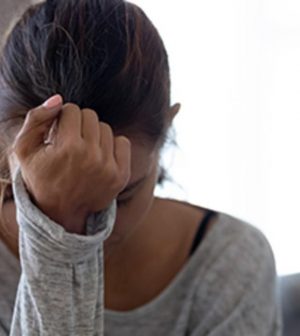- Fragments of Bird Flu Virus Found in U.S. Milk Supply
- There’s an ‘Epidemic’ of Loneliness Among U.S. Parents, Poll Finds
- Infertility Is Rising Among Young Married Women
- New Rules Mean 3.6 Million Americans Could Get Wegovy Via Medicare, Costing Billions
- ‘Dream It, Be It?’ Study Finds Teens Who Focus on Life Goals Often Succeed
- Trying ‘Magic Mushroom’ Drug to Ease Depression? It Has Side Effects
- $282 Billion: What Mental Illness Costs America Each Year
- Black, Hispanic Americans Getting Savvier About CPR
- Kids With Common Skin Conditions Face Stigma, Bullying
- Science Reveals How Aspirin Prevents Colon Cancer
The Most Common Anxiety Symptoms and How to Deal With Them

Anxiety disorders are no small matter, but knowing which symptoms point to trouble may help you navigate your intense fears and worries.
First, you are not alone: Anxiety disorders are estimated to plague nearly 40 million people in the United States each year, according to the Anxiety & Depression Association of America.
James Maddux, an emeritus professor of clinical psychology at George Mason University in Fairfax, Va., explained that “the best way of thinking about anxiety…is to see it as having three interlocking, interacting components”: thinking or cognition; feeling or emotions; and then behavior.
“Finding somewhere to intervene at one of those three points, that breaks up that pattern, is also a way of reducing or eliminating the physiological part of anxiety,” Maddux noted.
If you think you may be experiencing generalized anxiety disorder or any other type of anxiety, there are some telltale symptoms worth noting.
Here’s how you can recognize the most common anxiety symptoms, plus tips on how to calm them down if they flare up.
Common anxiety symptoms
The National Alliance on Mental Illness (NAMI) states that, while each type of anxiety is unique, they share some common symptoms:
- Anticipating the worst or an excessive fear of a threat
- Rapid breathing
- Pounding heart or heart palpitations
- Fatigue
- Sweating and shaking
- Nausea, diarrhea and increased urination
- Restlessness or irritability
Anticipating the worst or excessive fear of a threat
“Typically, the cognitive component of any anxiety problem is the expectation or prediction that something bad is going to happen,” said Maddux.
This excessive thinking about something terrible happening to you can be caused by several factors, according to NAMI. These include:
- Negative or traumatic life experiences
- A family history of anxiety
- Long-term illness
So how can you deal with your excessive fear?
Maddux noted that, while the natural reaction is to escape the situation or avoid it altogether, this tends to make things worse over the long term.
Instead, he recommended using cognitive behavioral therapy (CBT) and guided exposure therapy to work on becoming “more aware of what we are thinking and feeling, then…be able to assume more control over it.”
He suggested one way to do this is through meditation because “you’re learning to observe what’s happening in your brain. And anytime you become more aware of those things, they become a little easier to control. So, that can build over time…some resistance and some resilience to situational anxiety.”
Rapid breathing
Once you start thinking worrisome or fearful thoughts, your brain’s amygdala sends a crisis signal to your brain’s command center, the hypothalamus.
Your hypothalamus then signals your sympathetic nervous system and it kicks your stress response into gear by telling your adrenal glands to release epinephrine. Other stimulating hormones like cortisol may also be released if the perceived danger continues.
This response is sometimes referred to as “fight or flight,” according to Harvard Health.
One of its consequences? Your breathing becomes rapid and shallow.
On the upside, breathing may be the only physical anxiety symptom that is also its own solution.
“The rate and depth we breathe at is a huge determinant of our mental state,” University of California, San Francisco professor of psychiatry Elissa Epel, said in a recent article.
“If we’re breathing really shallowly and fast, it causes our nervous system to up-regulate and we feel tense and anxious. If we’re breathing slowly, it actually turns on the anti-stress response,” she noted.
Breathing exercises and yoga practices like a Tibetan form of breathing and meditation called “tummo” can help you learn to decrease your rate of breathing and even improve other anxiety symptoms.
Heart palpitations
According to the Cleveland Clinic, the most common cause of heart palpitations outside of heart problems is anxiety. These can manifest as a pounding or racing heart, irregular heartbeat or a fluttering in your chest.
Like rapid breathing, heart palpitations are caused by the fight-or-flight response.
Diaphragmatic breathing exercises, massage therapy and biofeedback treatments can help slow your heart rate. Exercising, especially yoga or tai chi, can also bring on a more relaxed state. This also helps other symptoms triggered by the fight-or-flight response, such as nausea, diarrhea, restlessness, irritability, sweating and shaking.
Fatigue
Fatigue or exhaustion can be a result of the constant worry associated with anxiety, states NAMI.
You also may experience fatigue after a fight-or-flight response when your parasympathetic nervous system works to calm your mind-body systems down. The U.S. National Library of Medicine notes that this response’s main role is to help you conserve your energy and “rest and digest.”
Getting enough sleep is one of the main ways to overcome fatigue.
Anti-anxiety medication may also be prescribed to treat the multiple symptoms of anxiety.
According to Anxiety.org, antidepressants such as serotonin-norepinephrine reuptake inhibitors (SNRIs) and selective serotonin reuptake inhibitors (SSRIs) can be part of an anxiety treatment plan as well.
One of their potential benefits is that they may increase your brain’s neuroplasticity. This can make it easier to rewire your brain to think more positive thoughts — and increase your resistance to anxiety.
Source: HealthDay
Copyright © 2024 HealthDay. All rights reserved.










